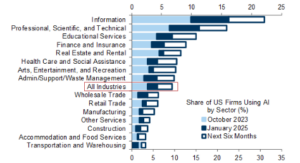Artificial Intelligence, Motorcycles, and Speed
February 7, 2025
To Inform:
If you’ve picked up a newspaper or tuned into financial media lately, it’s not a secret that the stock market is trading at high valuations relative to history. Some of this is no doubt a result of the success many American companies have had over the last several years across a range of industries. With that in mind I want to focus on one area of the market where valuations are particularly high: large technology companies and those in other industries with exposure to the artificial intelligence “theme.” These stocks have been the darlings of the market over the last 12-18 months as they’ve posted record profits on the sale of semiconductors to servers to electrical equipment and everything in between. The market has rewarded this success with record valuations.
I think of market valuations as a bit like riding a motorcycle. If someone is puttering down a residential street on a bike and a soccer ball rolls out in front of them the wheel may wobble and maybe even the bike gets laid down, but it likely isn’t going to be that big of a deal. Now, instead of puttering down a residential street, imagine a motorcycle whizzing along on the freeway. Here, the room for error is much lower. A bit of tire scrap or a large rock could spell disaster. It’s no different with markets. When stocks are relatively cheap, they can handle the errant soccer ball. When they are trading at premium valuations, it doesn’t take much to cause an accident.
We saw this in late January when the still hazy implications of China’s DeepSeek artificial intelligence tool came into clearer focus on Wall Street. The basic gist is that DeepSeek was developed on a shoestring budget with a lot less processing power. This unexpected rock on the road spelled trouble for many U.S. companies that are either providing the “picks and shovels” to artificial intelligence companies or the ones who themselves are developing artificial intelligence tools. One particularly popular stock shed over $400 billion in market value on January 27th alone! The damage across Wall Street was widespread with over $2 trillion in market value declines across the technology sector.
Is this all bad news, though? We’d argue that in the end, this could be a good thing for the rest of the market. The S&P 500 Equal-Weight Index was better than the size-weighted S&P 500 by more than 2% on Monday. The Joseph Group’s Investment Operations Associate and aspiring market technician Andrew Burkey shared with us that Monday was the only time in the S&P 500’s history as a 500-stock index (going back to 1957) when more than 300 stocks in the index were up on a day in which the overall index was down.
So, what is the upshot here? Why should we shrug off a day where a lot of important US companies were down more than 10%? It goes back to the impact of these artificial intelligence tools. Why are so many people excited about the investment implications of artificial intelligence? One big reason is the potential boost it could provide to productivity. The chart below from Goldman Sachs shows the adoption rate of artificial intelligence tools by industry. Just 5% of all industries in the US report utilization of artificial intelligence. If it becomes cheaper and easier to use it follows that more companies may begin adopting it, increasing productivity, and ultimately increasing profits.

Source: Goldman Sachs
And it may not all be bad news for the companies providing the tools and infrastructure for artificial intelligence. A paradox I stumble across time and again is one called the Jevons Paradox. The main idea here is that the cheaper and more efficient a technology becomes its cost goes down. This lower cost spurs more consumption of the technology and thus the providers still come out ok because even though they may be providing the technology for a lower price, increased demand has led to an increase in sales. This isn’t too dissimilar to the idea that increasing lanes on a highway makes traffic congestion worse!
Our approach to this important market theme is a diversified one. We believe there is value in many of the funds and companies that were dinged by the market on Monday. But we’ve also decided to not put all our client’s eggs in one basket. We’ve looked for and invested in companies and areas of the market that could be beneficiaries of a more efficient, cost-effective implementation of artificial intelligence. In short, having more than one motorcycle on the road makes more sense to us than always staying on the freeway or never having the courage to venture outside the neighborhood.

Written by Alex Durbin, CFA, Chief Investment Officer